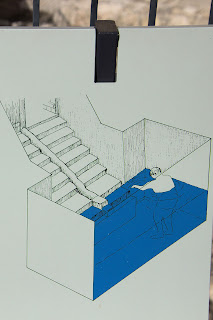The Southern Wall of the Temple Mount, and its set of steps, were the main way into the Temple for the common Jew. Deuteronomy 16:16 reads: "
Each year every man in Israel must celebrate these three festivals: the Festival of Unleavened Bread, the Festival of Harvest, and the Festival of Shelters. On each of these occasions, all men must appear before the Lord your God at the place he chooses, but they must not appear before the Lord without a gift for him." Once the Temple was completed in Jerusalem, that "place" chosen by the Lord was the Temple.
Before entering the temple, a worshiper was expected to cleanse himself with a ritual bath in a mikveh (see photos below). Then they would climb the steps on the south side of the Temple Mount and enter through the Huldah Gates. There was a set of three gates on the right side of the wall (the Eastern Huldah Gates) and two gates on the left side of the wall (the Western Huldah Gates). The gates actually led the worshiper into a tunnel which would bring them down underneath the Temple, and then upwards to the courtyard.
As you can see from the pictures on the signs below, the steps were quite long. At each of the festivals, there were probably thousands of people on these steps preparing to enter the Temple, or exiting it.
A number of scholars believe that these steps were also where the Church, in
Acts 2, had its beginning (rather than the Upper Room). During the Feast of Pentecost, also called the Feast of Weeks, there would have been thousands of Jews on these steps making their way into the Temple. Including Peter and the disciples, because 9am was the time for morning prayers! Just one more thing to think about!
 |
| An artist's rendering of the southern wall of the Temple Mount and its steps. Note the three gates on the right side and the two gates on the left side. |
 |
| This is a scale model of the Old City of Jerusalem, and Second Temple, that is on the grounds of the Israel Museum. You can see the Southern Wall and Steps, and in the lower right-hand corner, one of the western Hulda Gates. |
 |
| Looking down the wall towards the Mount of Olives |
 |
| The steps that remain |
 |
| Some of the steps are original to the 2nd Temple period - i.e. the 1st century! |
 |
| Worshipers purified themselves, before climbing the steps to enter the Temple, in a Mikveh bath |
 |
| Looking down into an excavated Mikveh. Approximately 50 Mikvehs have been uncovered by archaeologists in the southern wall area of the Temple Mount |
 |
| The three Hulda Gates on the eastern side of the Southern Wall |
 |
| A close up shot |
 |
| One half arch is all that remains of the Hulda Gates on the western side of the Southern Wall. |
 |
| A close-up of the half arch |
 |
| A little easier to see the details on the arch |
 |
| In the time of the 2nd Temple (also called Herod's Temple) the building known as Solomon's Colonnade (see the photo of the model of the Temple Mount, and Solomon's Colonnade above) was on top of the Southern Wall. Today, there is a building associated with the Al Aqsa mosque. You can see a bit of the dome of the mosque in the upper left-hand corner. |
 |
| Shot from the City of David, this photo shows the Al Aqsa mosque, fragment of the western Hulda Gate, and some of the Southern Steps. |
 |
| This is the perpendicular wall that runs out of where the two Hulda Gates on the western side of the Southern Wall were |
 |
| The Al Aqsa mosque |
 |
| The al-Fakhariyya minaret. One of four different minarets on the Temple Mount |
 |
| A shot of the al-Fakhariyya minaret and the dome of Al Aqsa mosque, on top of the Temple Mount |
 |
| The Dome of the Rock shrine can be seen on top of the Temple Mount |
 |
| The Bab al-SilSila minaret on top of the Temple Mount |
 |
| Another shot of the al-Fakhariyya minaret |
 |
| Flowers with the Al Aqsa mosque in the background |




























No comments:
Post a Comment